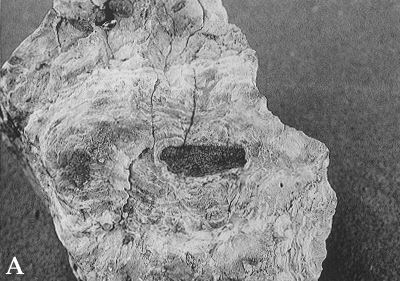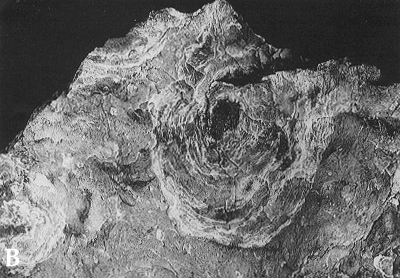

Organic coatings on grains: rhodoliths
Plate 144


Organic coatings on grains: rhodoliths
Plate 144
Stromatolitic laminae can coat also mobile objects, such as shells and pebbles rolled or suspended by water turbulence; they will then grow concentrically around a core and take the name of oncoliths or oncolitic structures. If the oncolith is being continually moved, the coating can surround it entirely; if, on the other hand, it sticks to the bottom, its growth can continue only on the upper, free surface.
Oncoliths look like the objects shown in these pictures, which by the way are not oncolites but rhodoliths (it cannot be written rhodolite as this is the name of a mineral). The coating is here made not by mucilaginous filaments and trapped sediment, but by thin crusts of calcium carbonate secreted by coralline red algae (Melobesiae or Rhodophyceae ), which are benthic and need a firm substrate. Rhodoliths are real (body) fossils and real algal structures. The carbonate fixed in their tissues is micro-crystalline (micrite); it looks white in polished sections like those of the pictures, dark (opaque) in thin sections.
Both oncolites and rhodoliths form in shallow, agitated waters; in this respect, they can be used as indicators. More specifically, each of these structures characterizes different sub environments and ecotopes within carbonate depositional environments, from extensive platforms to more restricted banks, reefs, shoals, etc.
There are other types of coated and encrusted particles, whose envelopes are purely chemical precipitates. They are included under the heading "chemical and diagenetic" structures in this book, but could as well be classified, together with biogenic types, as concretionary structures. This is another example of the limits and subjectivity of every scheme of classification.
Miocene and Pliocene organic limestone (ancient fossil banks), northern Apennines.